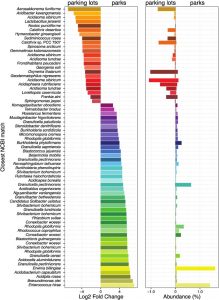This one has been getting a lot of popular media attention… and really the title says it all “Evidence of Long-Distance Droplet Transmission of SARS-CoV-2 by Direct Air Flow in a Restaurant in Korea”. This study describes a transmission that took place at over 20 feet in only 5 minutes… both problematic considering the standard …
Shelly Miller gives an interesting talk about “Building Engineering Controls for Improving Occupant Health: Mitigating Airborne Particles, Toxic Gases, and Infectious Aerosols.” This was recorded at the MoBE 2017 symposium in Washington D.C. If you’re interested, check out all of the other speakers from MoBE 2017 on our YouTube channel!
Quick post – paper of interest: Urban greenness influences airborne bacterial community composition Abstract Urban green space provides health benefits for city dwellers, and new evidence suggests that microorganisms associated with soil and vegetation could play a role. While airborne microorganisms are ubiquitous in urban areas, the influence of nearby vegetation on airborne microbial communities …
Autumn is not just a beautiful season in which multicolored leaves fall to the ground from their branches. It is also a good time for all kinds of microbes to flourish with the new addition of delicious leaf litter nutrients. A new paper from Irga et al studies the connection between the fungi found on leaf litter and …
Time for an update with recent papers on the microbes of the built environment. I have many, so I will break them up into two different posts. Microbes in buildings Microbial Density on Electronic Devices – Sulan Kith – Int.J.Curr.Microbiol.App.Sci Human participants each used an tablet, smart phone and media player for 20 minutes. We predicted that microbial density would …
A recent study from Meadow et al at the University of Oregon looked at the individual microbiota that humans shed into their surrounding environment. They sequenced the airborne microbes that colonized a sterile chamber once each individual entered. They found that this left a microbially distinct and detectable signature, much like a fingerprint, after 1.5-4 hours. …
The Department of Civil and Environmental Engineering at Virginia Tech invites applications for a postdoctoral researcher to study the influence of aerosol chemistry on the infectivity of airborne influenza viruses. The successful candidate must hold a doctoral degree and demonstrate appropriate background in environmental engineering, atmospheric chemistry, biology, biomedical engineering, chemical engineering, or mechanical engineering. …


